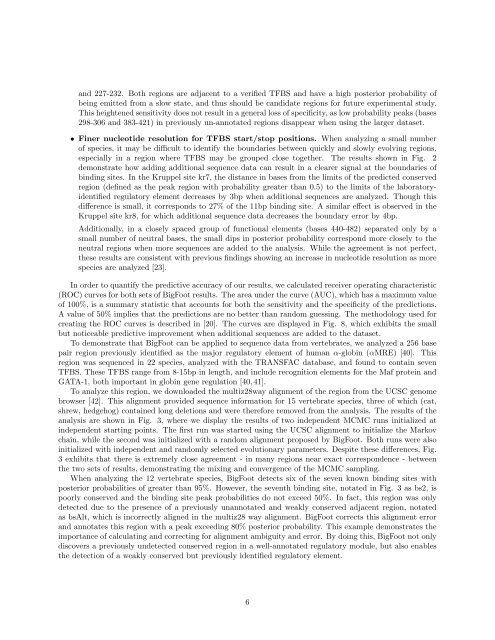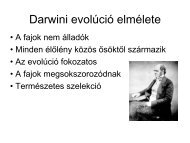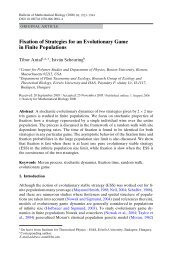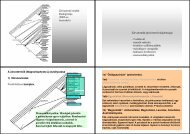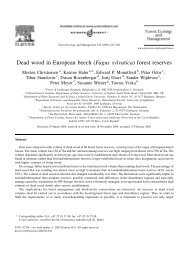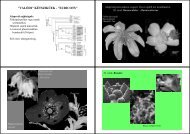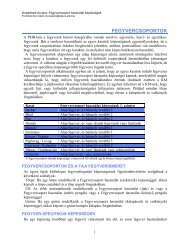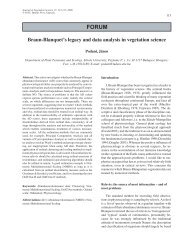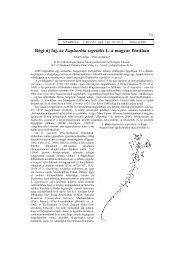BigFoot: Bayesian Alignment and Phylogenetic Footprinting with ...
BigFoot: Bayesian Alignment and Phylogenetic Footprinting with ...
BigFoot: Bayesian Alignment and Phylogenetic Footprinting with ...
Create successful ePaper yourself
Turn your PDF publications into a flip-book with our unique Google optimized e-Paper software.
<strong>and</strong> 227-232. Both regions are adjacent to a verified TFBS <strong>and</strong> have a high posterior probability ofbeing emitted from a slow state, <strong>and</strong> thus should be c<strong>and</strong>idate regions for future experimental study.This heightened sensitivity does not result in a general loss of specificity, as low probability peaks (bases298-306 <strong>and</strong> 383-421) in previously un-annotated regions disappear when using the larger dataset.• Finer nucleotide resolution for TFBS start/stop positions. When analyzing a small numberof species, it may be difficult to identify the boundaries between quickly <strong>and</strong> slowly evolving regions,especially in a region where TFBS may be grouped close together. The results shown in Fig. 2demonstrate how adding additional sequence data can result in a clearer signal at the boundaries ofbinding sites. In the Kruppel site kr7, the distance in bases from the limits of the predicted conservedregion (defined as the peak region <strong>with</strong> probability greater than 0.5) to the limits of the laboratoryidentifiedregulatory element decreases by 3bp when additional sequences are analyzed. Though thisdifference is small, it corresponds to 27% of the 11bp binding site. A similar effect is observed in theKruppel site kr8, for which additional sequence data decreases the boundary error by 4bp.Additionally, in a closely spaced group of functional elements (bases 440-482) separated only by asmall number of neutral bases, the small dips in posterior probability correspond more closely to theneutral regions when more sequences are added to the analysis. While the agreement is not perfect,these results are consistent <strong>with</strong> previous findings showing an increase in nucleotide resolution as morespecies are analyzed [23].In order to quantify the predictive accuracy of our results, we calculated receiver operating characteristic(ROC) curves for both sets of <strong>BigFoot</strong> results. The area under the curve (AUC), which has a maximum valueof 100%, is a summary statistic that accounts for both the sensitivity <strong>and</strong> the specificity of the predictions.A value of 50% implies that the predictions are no better than r<strong>and</strong>om guessing. The methodology used forcreating the ROC curves is described in [20]. The curves are displayed in Fig. 8, which exhibits the smallbut noticeable predictive improvement when additional sequences are added to the dataset.To demonstrate that <strong>BigFoot</strong> can be applied to sequence data from vertebrates, we analyzed a 256 basepair region previously identified as the major regulatory element of human α-globin (αMRE) [40]. Thisregion was sequenced in 22 species, analyzed <strong>with</strong> the TRANSFAC database, <strong>and</strong> found to contain sevenTFBS. These TFBS range from 8-15bp in length, <strong>and</strong> include recognition elements for the Maf protein <strong>and</strong>GATA-1, both important in globin gene regulation [40, 41].To analyze this region, we downloaded the multiz28way alignment of the region from the UCSC genomebrowser [42]. This alignment provided sequence information for 15 vertebrate species, three of which (cat,shrew, hedgehog) contained long deletions <strong>and</strong> were therefore removed from the analysis. The results of theanalysis are shown in Fig. 3, where we display the results of two independent MCMC runs initialized atindependent starting points. The first run was started using the UCSC alignment to initialize the Markovchain, while the second was initialized <strong>with</strong> a r<strong>and</strong>om alignment proposed by <strong>BigFoot</strong>. Both runs were alsoinitialized <strong>with</strong> independent <strong>and</strong> r<strong>and</strong>omly selected evolutionary parameters. Despite these differences, Fig.3 exhibits that there is extremely close agreement - in many regions near exact correspondence - betweenthe two sets of results, demonstrating the mixing <strong>and</strong> convergence of the MCMC sampling.When analyzing the 12 vertebrate species, <strong>BigFoot</strong> detects six of the seven known binding sites <strong>with</strong>posterior probabilities of greater than 95%. However, the seventh binding site, notated in Fig. 3 as bs2, ispoorly conserved <strong>and</strong> the binding site peak probabilities do not exceed 50%. In fact, this region was onlydetected due to the presence of a previously unannotated <strong>and</strong> weakly conserved adjacent region, notatedas bsAlt, which is incorrectly aligned in the multiz28 way alignment. <strong>BigFoot</strong> corrects this alignment error<strong>and</strong> annotates this region <strong>with</strong> a peak exceeding 80% posterior probability. This example demonstrates theimportance of calculating <strong>and</strong> correcting for alignment ambiguity <strong>and</strong> error. By doing this, <strong>BigFoot</strong> not onlydiscovers a previously undetected conserved region in a well-annotated regulatory module, but also enablesthe detection of a weakly conserved but previously identified regulatory element.6


